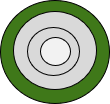E. Bubbles, Axes, and Optics, Oh My!
1. Bubbles
Most surveying equipment has a bubble to facilitate being correctly oriented to gravity. Two kinds of bubbles are used: bubble tube and circular bubble. Figure E-1 shows top and side view of both.
|
Top View |
|
|
|
|
|
Side View |
|
|
|
|
|
a. Tube |
b. Circular |
|
Figure E-1 |
|
The axis of the bubble tube (ABT) is a line tangent to the center of the upper curved surface of the bubble, Figure E-2.
|
|
|
|
a. Tube |
b. Circular |
|
Figure E-2 |
|
Technically, since a circular bubble is spherical, the ABT is actually a plane, Figure E-3, but we can refer to its edge view as the ABT.
|
|
|
Figure E-3 |
Bubble sensitivity is an expression of surface flatness. It is the angle at the curvature center for a specific surface distance, usually 2 mm, Figure E-4.
|
Figure E-4 |
A less curved (flatter) surface has a larger radius and smaller angle than a more curved surface. A flat surface means the bubble responds more quickly (is more sensitive) to vertical movement. Most contemporary tube bubbles have a sensitivity in the range of 20" to 30 ", a circular bubble is typically 10'.




